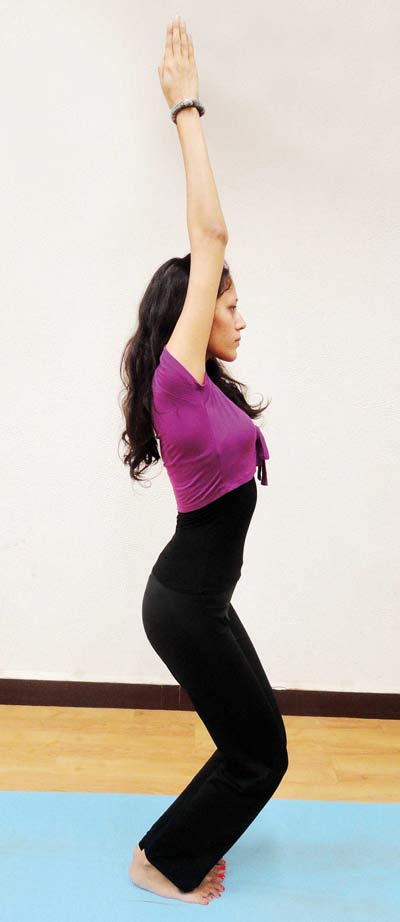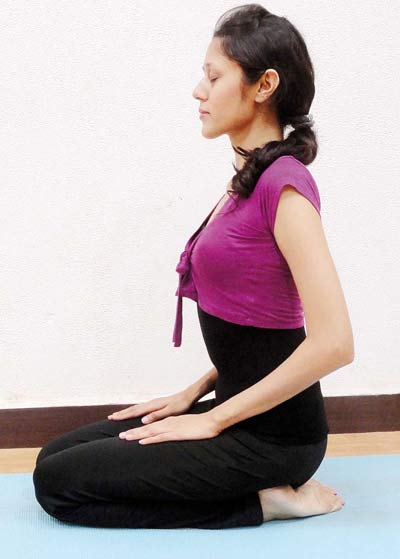Mountain pose: Tadasana

This is the ABC of yoga. You have to master this one before you progress further.
Stand with your feet together. Distribute your weight evenly along the entire length of your feet. Stretch your hands out straight by the side. Relax your shoulders and let your shoulder blades slide down. This will gently push your chest out. Keep your head straight and chin parallel to the ground. Stay in this pose for 10 breaths. You can even bring the palms together in the namaste position in front of your chest. Most asanas begin and conclude with tadasana.
Benefits: Creates a sense of stability and prepares your mind and body for the session to follow.
Boat pose: Naukasana
 This asana is an excellent ab-strengthener. Lie on your back with your legs stretched out and arms rested by the sides. Breathe in; as you exhale, use your core muscles to lift your hands, torso and both legs together. Fix your gaze on your toes and remain in this pose for five breaths. Be careful not to hold your breath while doing this asana.
This asana is an excellent ab-strengthener. Lie on your back with your legs stretched out and arms rested by the sides. Breathe in; as you exhale, use your core muscles to lift your hands, torso and both legs together. Fix your gaze on your toes and remain in this pose for five breaths. Be careful not to hold your breath while doing this asana.
Benefits: Strengthens the abdominal muscles and improves digestion.
Warrior pose: Virabhadrasana
 Keep your legs about three feet apart. Stretch your hands out on either sides, in line with the shoulders. Turn the right foot out. Bend the right knee, making a right angle at your knee joint. Look towards the right, keeping your gaze on the finger tips of the right hand. Hold the pose for five breaths and repeat with your left foot.
Keep your legs about three feet apart. Stretch your hands out on either sides, in line with the shoulders. Turn the right foot out. Bend the right knee, making a right angle at your knee joint. Look towards the right, keeping your gaze on the finger tips of the right hand. Hold the pose for five breaths and repeat with your left foot.
Benefits: Helps improve stamina and boost self-confidence. It works as a corrective exercise for those with flat feet.
Powerful pose: Utkatasana
 Begin in mountain pose. As you inhale, sweep your hands up from the sides and bring the palms to touch each other above the head—reach out as high as you can, stretching your torso and elongating the spine. Now, keeping the feet firmly grounded, exhale and bend your knees to squat. Go as low as you are comfortable going. Hold the pose for five breaths, gradually increasing the duration with practice.
Begin in mountain pose. As you inhale, sweep your hands up from the sides and bring the palms to touch each other above the head—reach out as high as you can, stretching your torso and elongating the spine. Now, keeping the feet firmly grounded, exhale and bend your knees to squat. Go as low as you are comfortable going. Hold the pose for five breaths, gradually increasing the duration with practice.
Benefits: Helps you stay balanced and maintain your focus; also strengthens the calves and thighs.
Cobra pose: Bhujangasana
 Lie on your belly with your toes stretched out. Place your palms flat on the ground by the side of your chest such that your elbows are pointing upwards. Your forearms must not rest on the mat. To start, keep your forehead on the mat and as you inhale, lift your head and shoulders up. If you’re a beginner, stay in this position for five breaths and release. To progress to the next level, slide your hands slightly forward and lift your head and shoulders higher. This accentuates the curve of the back bend.
Lie on your belly with your toes stretched out. Place your palms flat on the ground by the side of your chest such that your elbows are pointing upwards. Your forearms must not rest on the mat. To start, keep your forehead on the mat and as you inhale, lift your head and shoulders up. If you’re a beginner, stay in this position for five breaths and release. To progress to the next level, slide your hands slightly forward and lift your head and shoulders higher. This accentuates the curve of the back bend.
Benefits: Improves spinal flexibility and eases back and neck stiffness; also helps relieve sciatica pain and firms the gluteal [buttock] muscles.
Thunderbolt: Vajrasana
 Begin by kneeling on your mat with the toes stretched out, not curled in. Keep the knees and feet together. Now move your heels away from each other and sit in the space that is created between the feet. If the ankles hurt too much, place a rolled towel/yoga mat or a small cushion between the thighs and the calves or below the ankles. Place the palms on the knees and keep the back, neck and head straight. This pose is commonly assumed in meditation.
Begin by kneeling on your mat with the toes stretched out, not curled in. Keep the knees and feet together. Now move your heels away from each other and sit in the space that is created between the feet. If the ankles hurt too much, place a rolled towel/yoga mat or a small cushion between the thighs and the calves or below the ankles. Place the palms on the knees and keep the back, neck and head straight. This pose is commonly assumed in meditation.
Benefits: Improves digestion and strengthens the muscles of the pelvic floor.
Wind-relieving pose: Pawanmuktasana
 Lie on your back with the hands by your sides. As you exhale, lift both the legs, bend the knees and draw them in towards the chest. Press the thighs over the abdomen with your arms [like hugging your thighs] Once you are comfortable doing this, lift your head towards the knees and aim to touch the forehead or chin on the knees.
Lie on your back with the hands by your sides. As you exhale, lift both the legs, bend the knees and draw them in towards the chest. Press the thighs over the abdomen with your arms [like hugging your thighs] Once you are comfortable doing this, lift your head towards the knees and aim to touch the forehead or chin on the knees.
Benefits: Helps relieve constipation and flatulence and improves spinal mobility and strength.
Shavasana: Corpse pose
 This one’s sure to bring a smile to many faces and you might wonder what’s there to learn in this asana. Relaxation is not the same as lying down on your mat while your mind is running crazy. It is not even the equivalent of dozing off to sleep. Shavasana involves conscious relaxation, and is as important an asana as any of the above. Any yoga session must include relaxation and cooling down—shavasana helps you with that. Hence, it is done at the end of the session. Lie on your back with the hands stretched out by the side and away from the body. Also keep the legs apart with toes facing out. You may also turn the face to one side. Breathe slowly and let the body slip into a state of deep relaxation.
This one’s sure to bring a smile to many faces and you might wonder what’s there to learn in this asana. Relaxation is not the same as lying down on your mat while your mind is running crazy. It is not even the equivalent of dozing off to sleep. Shavasana involves conscious relaxation, and is as important an asana as any of the above. Any yoga session must include relaxation and cooling down—shavasana helps you with that. Hence, it is done at the end of the session. Lie on your back with the hands stretched out by the side and away from the body. Also keep the legs apart with toes facing out. You may also turn the face to one side. Breathe slowly and let the body slip into a state of deep relaxation.
Benefits: Relaxes mind and body; also helps in regulating blood pressure and heart rate.
This was first published in the December 2011 issue of Complete Wellbeing.
